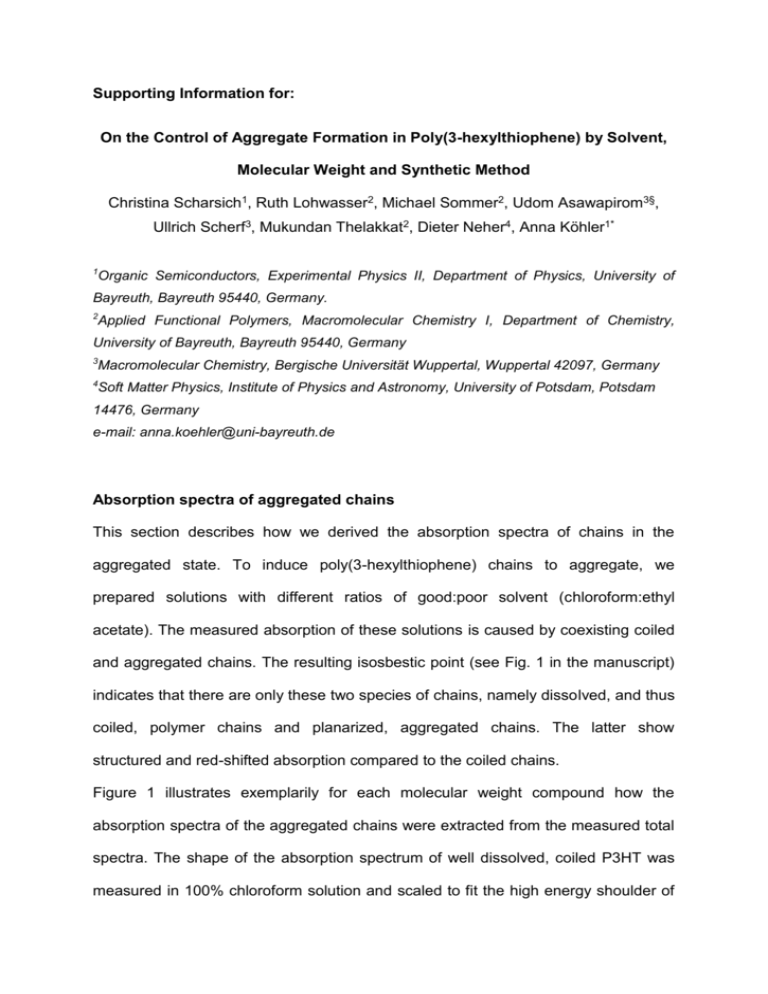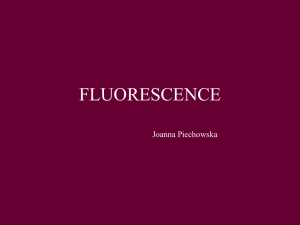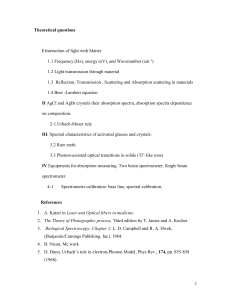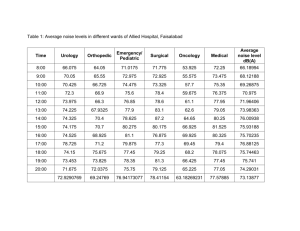POLB_23022_sm_SuppInfo
advertisement

Supporting Information for: On the Control of Aggregate Formation in Poly(3-hexylthiophene) by Solvent, Molecular Weight and Synthetic Method Christina Scharsich1, Ruth Lohwasser2, Michael Sommer2, Udom Asawapirom3§, Ullrich Scherf3, Mukundan Thelakkat2, Dieter Neher4, Anna Köhler1* 1 Organic Semiconductors, Experimental Physics II, Department of Physics, University of Bayreuth, Bayreuth 95440, Germany. 2 Applied Functional Polymers, Macromolecular Chemistry I, Department of Chemistry, University of Bayreuth, Bayreuth 95440, Germany 3 Macromolecular Chemistry, Bergische Universität Wuppertal, Wuppertal 42097, Germany 4 Soft Matter Physics, Institute of Physics and Astronomy, University of Potsdam, Potsdam 14476, Germany e-mail: anna.koehler@uni-bayreuth.de Absorption spectra of aggregated chains This section describes how we derived the absorption spectra of chains in the aggregated state. To induce poly(3-hexylthiophene) chains to aggregate, we prepared solutions with different ratios of good:poor solvent (chloroform:ethyl acetate). The measured absorption of these solutions is caused by coexisting coiled and aggregated chains. The resulting isosbestic point (see Fig. 1 in the manuscript) indicates that there are only these two species of chains, namely dissolved, and thus coiled, polymer chains and planarized, aggregated chains. The latter show structured and red-shifted absorption compared to the coiled chains. Figure 1 illustrates exemplarily for each molecular weight compound how the absorption spectra of the aggregated chains were extracted from the measured total spectra. The shape of the absorption spectrum of well dissolved, coiled P3HT was measured in 100% chloroform solution and scaled to fit the high energy shoulder of the examined solution spectrum without changing its position. This scaled spectrum of the coiled chains was then subtracted yielding the absorption spectrum due to pure aggregates present in the according solution. Figure 1 Measured absorption spectra for solutions with good:poor solvent (CHCl3:EtAc) (black line) containing coexisting coiled and aggregated chains. The absorption of well dissolved, coiled P3HT in 100% chloroform (red line) was scaled to fit the high energy shoulder of the solution spectrum. The spectrum of the coiled chains was then subtracted yielding the absorption due to aggregates (blue line). Determination of relative oscillator strength For our interpretation, we need to know the fraction of chains that are aggregated. Above, we have derived which fraction of absorption is due to aggregates. However, the fraction of aggregate absorption is not equal to the fraction of aggregates, since the chain may have different oscillator strength in the coiled form and in the aggregated form. The relative oscillator strength describes the change in oscillator strength when going from coiled to aggregated P3HT chains. Knowledge of this relative oscillator strength is therefore necessary to determine the fraction of aggregates from the area of the aggregate absorption. To determine the relative oscillator strength, we followed the procedure by Clark et al. 1 Figure 2 illustrates the procedure. As outlined above, the total absorption spectrum (blue solid line) can be deconvoluted into the absorption caused by dissolved, coiled chains (black dashed line) and the absorption caused by aggregated chains (blue dashed line). The change in absorption of the coiled chains, Acoiled, corresponds to the difference between the spectrum from 100% coiled chains (black solid line) and the fraction of absorption by the coiled chains in the measured spectrum (black dashed line). In the left part of Figure 2, Acoiled is indicated by the shaded area. The corresponding increase in absorption of the aggregated chains, Aaggregate, is given by the absorption of the aggregated chains formed (blue dashed line). Aaggregate is shown as shaded area in the right part of Figure 2. Any difference between the decrease of absorption by coiled chains and the increase in absorption by aggregated chains must arise from a change in relative oscillator strength F as follows. F ΔA aggregate ΔA coiled (1) Figure 2 Exemplarily absorption spectra for P3HT solutions with solvent induced aggregate absorption (blue solid line) indicating the change in oscillator strength between coiled and aggregated chains (grey areas). The absorption of 100% well dissolved, coiled chains is presented as solid black line. The dashed lines show the absorption due to aggregated (dashed blue line) and coiled (dashed black line) chains, respectively. Top figures show absorption of 30:70 (CHCl3:EtAc) solution of the defined 5 kD sample and bottom figures show 80:20 (CHCl3:EtAc) solution of the 11 kD sample. The resulting change in relative oscillator strength F for solutions with different ratios of good:poor solvent (chloroform:ethyl acetate) for the defined and extracted poly(3hexylthiophene) compounds is summarized in Figure 3. Clark et al. obtained a relative oscillator strength of (1.39 ± 0.10) for commercial P3HT in solution going from 70° C to room temperature. This is in good agreement with the relative oscillator strength we obtained for the solutions of the 19 kD samples with 25% of poor solvent and higher. Figure 3 The relative oscillator strength between coiled and aggregated P3HT chains as function of poor solvent fraction for defined and extracted P3HT as indicted in the figure. The molecular weight increases from top to bottom. Franck-Condon analysis The quantitative analysis of the P3HT aggregate absorption yields the excitonic coupling J between the polymer chains within these aggregates. According to the work of Spano2, the coupling is determined by the ratio of the first two absorption peaks, A0-0/A0-1, as follows 𝑆𝜈 𝐽 𝐴0−0 𝐴0−1 = 𝑛0−0 𝑛0−1 2 (1−𝜔 𝑒 −𝑆 ∑𝜈>0𝜈!𝜈) 0 𝑆𝜈 𝐽 2 , 𝑆(1−𝜔 𝑒 −𝑆 ∑𝜈≠1𝜈!(𝜈−1)) 0 where ω0 is the effective vibrational energy of the single emitter and S its Huang Rhys parameter, n0-0 and n0-1 refer to the refractive index at the position of A0-0 and A0-1. Thus, the correct determination of the excitonic coupling J requires the knowledge of Huang Rhys parameter S and the effective vibrational energy ω 0 of the single, i.e. non-aggregated, emitter. Both parameters can be extracted from a Franck-Condon analysis of the photoluminescence of the single emitter (a nonaggregated chain). Therefore, we measured photoluminescence spectra of dilute P3HT solutions in 100% chloroform. Figure 4 shows the experimental photoluminescence data (blue symbols). For the analysis of the excitonic coupling J, we need only a vibrational energy for an effective oscillation. Thus, a single mode Franck-Condon analysis is sufficient. In a Franck-Condon analysis, the photoluminescence spectrum is modeled as a sum of Gaussian shaped transitions, Γ, from the first excited state S1(m=0) to the ground state S0(m) with m=1,2,3,… being the vibration quantum number. 3 The fitting procedure demands a normalization of the photoluminescence signal P(ћω) given by P(ω) Sm Γδ[ω (ω 0 m ω i )] n 3 (ω)3 I 00 m m! , (2) where I0-0 is the intensity of the emission from the 0-0 vibrational level of the first excited state to the 0-0 vibrational level of the ground state. The integer m denotes the excitation level of the vibration with energy ћωi and n is the refractive index of the surrounding material at photon energy ћω. Here, the material surrounding the single emitters was the solvent, chloroform. Its refractive index was calculated from the Cauchy parameters published by Samoc. 4 Figure 4 Single mode Franck-Condon fits (red line) for the single emitter emission spectra in dilute solution for defined P3HT. The molecular weight increases from top to bottom. The experimental data (blue symbols) were fitted with Gaussian functions (grey lines) at four vibration levels. The residue is presented as cyan line. The Franck-Condon fits according to equation 2 were calculated using four vibrational levels (m= 0, 1, 2, 3, 4) of the effective oscillator ħω0 and yield the fitting parameters summarized in Table 1. The Franck-Condon fits (red line in Figure 4) reproduce the experimental data with high accuracy. Thus, the resulting parameters S and ω0 enable a precise calculation of the free excitonic coupling J. P3HT S ω0 σ 5 kD 0.90 1390 cm-1 0.084 eV 11 kD 0.84 1390 cm-1 0.079 eV 19 kD 0.84 1390 cm-1 0.080 eV Table 1 Fitting parameters of the Franck-Condon analyses for the poly(3-hexylthiophene) (P3HT) single emitter photoluminescence spectra: Huang Rhys parameter S, energy of effective oscillation ω0 and Gaussian standard deviation σ. Absorption spectra of thin films We want to investigate whether the results obtained for P3HT aggregates in solution can be transferred to P3HT films that were spun from solution already containing aggregates due to poor solvent fractions. Therefore, we studied the absorption of the P3HT thin films, shown in Figure 5 normalized to the 0-1 absorption peak for the defined P3HT samples. The absorption spectra of the films show both, a structured absorption due to aggregated chains at low energies and absorption around 2.8 eV and higher due to non-aggregated coiled chains in amorphous regions. We find that films spun from solutions containing fractions of poor solvent have higher 0-0 absorption indicating aggregates with lower excitonic coupling and thus higher conjugation length. Similar absorption spectra can be obtained for the extracted P3HT samples as well. Figure 5 Absorption spectra of thin films made from defined P3HT, normalized to the second absorption peak. Films were spun from solutions with ratios of good:poor solvent (CHCl3:EtAc) as indicted in the figure. Assessment of thermal equilibrium state in solution The absorption spectra of P3HT in a solvent mixture of chloroform and ethyl acetate do not show any changes on a 24 hour timescale. We therefore wanted to know whether the conformation obtained in such a solution corresponds to a thermal equilibrium state. To probe this, P3HT was dissolved in a chloroform:ethyl acetate 50:50 mixture at a concentration of 0.25 mg/ml prepared in two different ways. In the first approach, P3HT was fully dissolved in chloroform. Then, the necessary amount of ethyl acetate was added at once. In the second approach, P3HT was again fully dissolved in chloroform, but the necessary amount of ethyl acetate was added very slowly (0.4 ml/h) in small amounts while stirring using an automated syringe. The absorption spectra resulting from the two modes of preparation are different, with larger aggregates falling out of solution in the second mode of preparation. From this difference we infer that that the solutions prepared by the first mode are not in a thermal equilibrium state. References 1. Clark, J.; Chang, J. F.; Spano, F. C.; Friend, R. H.; Silva, C. Applied Physics Letters 2009, 94, 3. 2. Spano, F. C. Journal of Chemical Physics 2005, 122, -. 3. Ho, P. K. H.; Kim, J. S.; Tessler, N.; Friend, R. H. Journal of Chemical Physics 2001, 115, 2709-2720. 4. Samoc, A. Journal of Applied Physics 2003, 94, 6167-6174.







